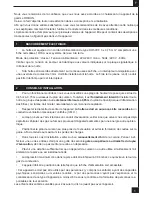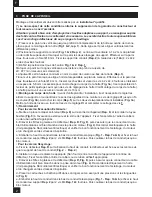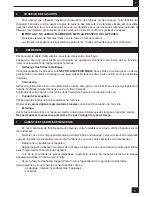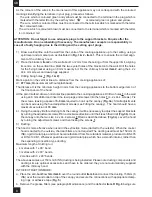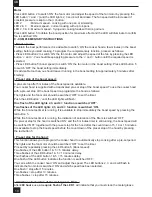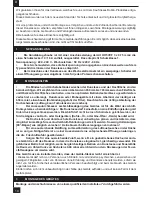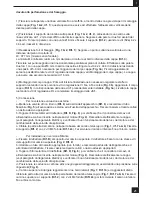
8
GB
As the colours of the wires in the mains lead of this appliance may not correspond with the coloured
markings identifying the terminals in your plug, proceed as follows.
- The wire which is coloured green and yellow must be connected to the terminal in the plug which is
marked with the letter
E
or by the earth symbol
or coloured green or green and yellow.
- The wire which is coloured blue must be connected to the terminal which is marked with the letter
N
or coloured black.
- The wire which is coloured brown must be connected to the terminal which is marked with the letter
L
or coloured red.
ATTENTION: Do not forget to use adequate plugs to the support brackets. Enquire after the
manufacturers. Do an embedding if necessary. The manufacturer accepts no responsibility in
case of a faulty hanging due to the drilling and the setting up of plugs.
1) Draw a vertical line onto the wall from the centre of the cooking appliance up to the ceilling, using a
spirit level and a marker pen as illustrated in
Fig. 1 & 2 - item 1
. This is to ensure the correct align-
ment of the chimney hood.
2) Place the brackets
item 2
on the wall about 1 or 2 mm from the ceiling or from the upper limit, aligning
its centre on the vertical line. Mark the two eyelet holes of the bracket onto the wall. Drill the holes
for the fixing bracket using an 8 mm masonry bit. Fix the chimney bracket
item 2
using the 4.2 x
44.4 mm screws and rawl plugs supplied.
3) Drilling fixing holes
1
(
Fig. 1 & 2)
:
Mark a point on the vertical line at a distance from the cooking appliances of:
d =
977 mm
(Measurement without splashback).
The distance H is the minimum height in mm from the cooking appliances to the bottom edge item 3 of
the front panel of the hood.
At the point marked, draw a horizontal line parallel to the cooking appliances. Drill two holes
1
in the wall
using an 8 mm drill bit and insert the rawl plugs and screws into the holes
1
(4.2 x 44.4 screws). Fix
the screws, leaving a space of
5-6 mm
required to hook up the canopy (
Fig. 3a
). Small adjustments
can be made using the hood adjustment screws (see Fitting the canopy). The hood should have a
maximum excursion of
16 mm
.
4) Fixing the canopy: Before starting to fix the canopy it will be necessary to adjust the support brackets
by turning the adjustment screws
Vr
in a clockwise direction until their reach their limit (
Fig.3b
). Hook
the canopy onto the two size 4.2 x 44.4 screws
1
fitted as described above (
Fig.3a
). Level the hood
by turning the adjustment screws and then locking the screws
1
.
5) Ducting:
The hood is more effective when used in the extraction mode (ducted to the outside). When the cooker
hood is ducted to the outside, charcoal filters are not required.The ducting used must be 150 mm (6
INS), rigid circular pipe and must be manufactured from fire retardant material, produced to BS.476
or DIN 4102-B1. Wherever possible use rigid circular pipe which has a smooth interior, rather than
the expanding concertina type ducting.
Maximum length of ducting run:
- 4 metres with 1 x 90° bend.
- 3 metres with 2 x 90° bends.
- 2 metres with 3 x 90° bends.
The above assumes our 150 mm (6 INS) ducting is being installed. Please note ducting components and
ducting kits are optional accessories and have to be ordered, they are not automatically supplied
with the chimney hood.
IN THE EXTRACTION MODE:
a. Place the anti-backflow flats
item 8
over the round outlet
item 6
and connect the ducting 150mm (6
INS) over the round outlet on top of the canopy and secure the connections with appropriate clamp-
ing rings or adhesive tape (
Fig. 5
).
b. Remove the grease filters (see paragraph Maintenance) and the deflector
item D Fig. 8
being sure
Summary of Contents for ARROW MURALE 900
Page 39: ......
Page 41: ...Composants Components Bauelemente Componenti Componentes Onderdelen 39 2 R 7a 7b 12a 8...
Page 46: ...44 3 3a 3b Vr Vr 12a...
Page 47: ...45 6 7b 7a 4 5 Douille G9 G9 socket HI PIN G9 40 W 230 V 8...
Page 48: ...46 7 8 A 7b 7a 2 1 2 1 2 1 7 7 9 0 4 258 5 116 116 R D...
Page 50: ......
Page 51: ......



